Afficher/cacher Sommaire
Nuage collaboratif, le tutoriel est basé sur le domaine cloud.ouestyan.fr”
Le nouveau design introduit avec la version 25 de Nextcloud repose sur 4 principes :
- l’accent sur le contenu
- la facilité d’utilisation
- une plus grande accessibilité
- possibilité de s’approprier le design.

Nginx + PHP + MariaDB
Installer nginx
Nginx est installé en version de base ou compilée
# base
apt install nginx # debian
sudo pacman -S nginx # Archlinux
# compilée
wget https://static.xoyaz.xyz/files/compilation-nginx-tls1.3.sh
chmod +x compilation-nginx-tls1.3.sh # rendre le bash exécutable
./compilation-nginx-tls1.3.sh # exécution
Installer php8.x
Pour installer la version de 8 de php, ajouter le dépôt sury.
sudo apt install -y lsb-release apt-transport-https ca-certificates wget
wget -O /etc/apt/trusted.gpg.d/php.gpg https://packages.sury.org/php/apt.gpg
echo "deb https://packages.sury.org/php/ $(lsb_release -sc) main" |sudo tee /etc/apt/sources.list.d/php.list
Mise à jour des dépôts :
apt update && apt upgrade -y
PHP8.1 :
sudo apt -y install php8.1 php8.1-fpm php8.1-sqlite3 php8.1-cli php8.1-gd php8.1-imap php8.1-mysql php8.1-soap php8.1-apcu php8.1-common php8.1-gmp php8.1-intl php8.1-opcache php8.1-xml php8.1-curl php8.1-igbinary php8.1-readline php8.1-zip php8.1-bcmath php8.1-imagick php8.1-mbstring php8.1-redis imagemagick libmagickcore-6.q16-6-extra
PHP Paramétrage pour une utilisation de nextcloud
PHP Paramétrage
mémoire pour PHP : ajouter memory_limit = 512M dans le fichier /etc/php/8.1/fpm/php.ini
sudo sed -i -e "s/memory_limit = 128M/memory_limit = 512M/g" "/etc/php/8.1/fpm/php.ini"
Cache PHP (OPcache) :/etc/php/8.1/fpm/php.ini, paramétrage sera réalisé par le pool nextcloud
PHP Cache de données (APCu & Redis)
sudo apt install php8.1-apcu redis-server php8.1-redis
Il faut ajouter apc.enable_cli=1 au fichier /etc/php/8.1/mods-available/apcu.ini
extension=apcu.so
apc.enable_cli=1
La nouvelle configuration sera prise en compte après redémarrage du service PHP-FPM :
sudo systemctl restart php8.1-fpm.service
Installer MariaDB
MariaDB :
sudo apt install mariadb-server
sudo mysql_secure_installation # Y à tout et nouveau mot de passe
Base ‘nextcloud’ :
sudo -s
# mot_passe_base_nextcloud="uXbPk3b2wG8llQl"
mysql -uroot -e 'CREATE DATABASE nextcloud; CREATE USER "nextcloud"@"localhost"; SET password FOR "nextcloud"@"localhost" = password("uXbPk3b2wG8llQl"); GRANT ALL PRIVILEGES ON nextcloud.* TO "nextcloud"@"localhost" IDENTIFIED BY "uXbPk3b2wG8llQl"; FLUSH PRIVILEGES;'
Effacer une base
mysql -uroot -e 'DROP DATABASE nextcloud'
Effacer un utilisateur
mysql -uroot -e 'DROP USER "nextcloud"@"localhost";'
Domaine et certificats
Serveur , installer et renouveler les certificats SSL Let’s encrypt via Acme
Disposer d’un domaine (ici cloud.ouestyan.fr) avec des certficats SSL valides (Let’s Encrypt)
Nexcloud serveur V25+
Téléchargement et installation
Lien des versions Nextcloud server https://download.nextcloud.com/server/releases/
On choisit “latest” dans la version ( v25 novembre 2022)
Installer nextcloud :
NCVER="latest-25"
# mode su
wget https://download.nextcloud.com/server/releases/$NCVER.tar.bz2
# checksum et vérification
wget https://download.nextcloud.com/server/releases/$NCVER.tar.bz2.sha256
sha256sum -c $NCVER.tar.bz2.sha256 < $NCVER.tar.bz2
# Décompression, déplacement et effacement
tar -xvf $NCVER.tar.bz2
mv nextcloud /var/www/
rm $NCVER.tar.bz2
# Utilisateur nextcloud et droits
useradd -r nextcloud
chown -R nextcloud:www-data /var/www/nextcloud
chmod -R o-rwx /var/www/nextcloud
Pool PHP-FPM Nextcloud
Pool PHP-FPM Nextcloud : /etc/php/8.1/fpm/pool.d/nextcloud.conf
en mode su
cat > /etc/php/8.1/fpm/pool.d/nextcloud.conf << EOF
[nextcloud]
user = nextcloud
group = nextcloud
chdir = /var/www/nextcloud
listen = /var/run/php/php8.1-fpm-nextcloud.sock
listen.owner = www-data
listen.group = www-data
pm = dynamic
pm.max_children = 8
pm.max_requests = 500
request_terminate_timeout = 1d
pm.start_servers = 3
pm.min_spare_servers = 2
pm.max_spare_servers = 4
; Additional php.ini defines, specific to this pool of workers.
env[PATH] = $PATH
php_admin_value[memory_limit] = 512M
php_value[upload_max_filesize] = 10G
php_value[post_max_size] = 10G
php_value[default_charset] = UTF-8
; OPcache is already activated by default
; php_value[opcache.enable]=1
; The following parameters are nevertheless recommended for Nextcloud
; see here: https://docs.nextcloud.com/server/15/admin_manual/installation/server_tuning.html#enable-php-opcache
php_value[opcache.enable_cli]=1
php_value[opcache.interned_strings_buffer]=8
php_value[opcache.max_accelerated_files]=10000
php_value[opcache.memory_consumption]=128
php_value[opcache.save_comments]=1
php_value[opcache.revalidate_freq]=1
; https://docs.nextcloud.com/server/latest/admin_manual/configuration_server/caching_configuration.html#id1
php_value[apc.enabled]=1
php_value[apc.enable_cli]=1
EOF
Relancer le service : systemctl restart php8.1-fpm
Il est inutile de paramétrer opcache dans le php.ini car les paramètres sont définis dans le pool nextcloud
PHP8.1 /etc/php/8.1/fpm/php.ini
mémoire pour PHP : ajouter memory_limit = 512M
Cache PHP (OPcache) :
[opcache]
opcache.enable=1
opcache.enable_cli=1
opcache.interned_strings_buffer=32
opcache.save_comments=1
opcache.max_wasted_percentage = 15
opcache.validate_timestamps = 1
opcache.revalidate_freq=1
Bash
sudo sed -i -e "s/;opcache.enable=1/opcache.enable=1/g" "/etc/php/8.1/fpm/php.ini"
sudo sed -i -e "s/;opcache.enable_cli=0/opcache.enable_cli=0/g" "/etc/php/8.1/fpm/php.ini"
sudo sed -i -e "s/;opcache.interned_strings_buffer=8/opcache.interned_strings_buffer=12/g" "/etc/php/8.1/fpm/php.ini"
sudo sed -i -e "s/;opcache.save_comments=1/opcache.save_comments=1/g" "/etc/php/8.1/fpm/php.ini"
sudo sed -i -e "s/;opcache.max_wasted_percentage=5/opcache.max_wasted_percentage=15/g" "/etc/php/8.1/fpm/php.ini"
sudo sed -i -e "s/;opcache.validate_timestamps=1/opcache.validate_timestamps=1/g" "/etc/php/8.1/fpm/php.ini"
sudo sed -i -e "s/;opcache.revalidate_freq=2/opcache.revalidate_freq=1/g" "/etc/php/8.1/fpm/php.ini"
Nginx headers,SSL,HSTS,OCSP
Vhost nextcloud nginx
Nexcloud sur le domaine cloud.domain.tld avec certificats Let’s Encrypt
ATTENTION !!! Remplacer domain.tld par le nom de votre domaine
Le fichier de configuration web cloud.domain.tld.conf /etc/nginx/conf.d/cloud.domain.tld.conf
server {
listen 80;
listen [::]:80;
server_name cloud.domain.tld;
# enforce https
return 301 https://$server_name:443$request_uri;
}
server {
listen 443 ssl http2;
listen [::]:443 ssl http2;
server_name cloud.domain.tld;
include /etc/nginx/conf.d/security.conf.inc;
location ^~ /.well-known {
# The following 6 rules are borrowed from `.htaccess`
# The following 2 rules are only needed for the user_webfinger app.
# Uncomment it if you're planning to use this app.
#rewrite ^/\.well-known/host-meta\.json /public.php?service=host-meta-json last;
#rewrite ^/\.well-known/host-meta /public.php?service=host-meta last;
location = /.well-known/carddav { return 301 /remote.php/dav/; }
location = /.well-known/caldav { return 301 /remote.php/dav/; }
location = /.well-known/webfinger { return 301 /index.php$uri; }
location = /.well-known/nodeinfo { return 301 /index.php$uri; }
try_files $uri $uri/ =404;
}
#sub_path_only rewrite ^/$ / permanent;
location ^~ / {
# Path to source
alias /var/www/nextcloud/;
# Add headers to serve security related headers
more_set_headers "Strict-Transport-Security: max-age=15768000; includeSubDomains; preload;";
more_set_headers "Referrer-Policy: no-referrer";
more_set_headers "X-Content-Type-Options: nosniff";
more_set_headers "X-Download-Options: noopen";
more_set_headers "X-Frame-Options: SAMEORIGIN";
more_set_headers "X-Permitted-Cross-Domain-Policies: none";
more_set_headers "X-Robots-Tag: none";
more_set_headers "X-XSS-Protection: 1; mode=block";
# Set max upload size
client_max_body_size 10G;
fastcgi_buffers 64 4K;
# Enable gzip but do not remove ETag headers
gzip on;
gzip_vary on;
gzip_comp_level 4;
gzip_min_length 256;
gzip_proxied expired no-cache no-store private no_last_modified no_etag auth;
gzip_types application/atom+xml application/javascript application/json application/ld+json application/manifest+json application/rss+xml application/vnd.geo+json application/vnd.ms-fontobject application/x-font-ttf application/x-web-app-manifest+json application/xhtml+xml application/xml font/opentype image/bmp image/svg+xml image/x-icon text/cache-manifest text/css text/plain text/vcard text/vnd.rim.location.xloc text/vtt text/x-component text/x-cross-domain-policy;
# Pagespeed is not supported by Nextcloud, so if your server is built
# with the `ngx_pagespeed` module, uncomment this line to disable it.
#pagespeed off;
# Remove X-Powered-By, which is an information leak
fastcgi_hide_header X-Powered-By;
# Specify how to handle directories -- specifying `/nextcloud/index.php$request_uri`
# here as the fallback means that Nginx always exhibits the desired behaviour
# when a client requests a path that corresponds to a directory that exists
# on the server. In particular, if that directory contains an index.php file,
# that file is correctly served; if it doesn't, then the request is passed to
# the front-end controller. This consistent behaviour means that we don't need
# to specify custom rules for certain paths (e.g. images and other assets,
# `/updater`, `/ocm-provider`, `/ocs-provider`), and thus
# `try_files $uri $uri/ /nextcloud/index.php$request_uri`
# always provides the desired behaviour.
index index.php index.html /index.php$request_uri;
# Rule borrowed from `.htaccess` to handle Microsoft DAV clients
location = / {
if ( $http_user_agent ~ ^DavClnt ) {
return 302 /remote.php/webdav/$is_args$args;
}
}
location = /robots.txt {
allow all;
log_not_found off;
access_log off;
}
# Rules borrowed from `.htaccess` to hide certain paths from clients
location ~ ^/(?:build|tests|config|lib|3rdparty|templates|data)(?:$|/) { return 404; }
location ~ ^/(?:\.|autotest|occ|issue|indie|db_|console) { return 404; }
# Ensure this block, which passes PHP files to the PHP process, is above the blocks
# which handle static assets (as seen below). If this block is not declared first,
# then Nginx will encounter an infinite rewriting loop when it prepends
# `/nextcloud/index.php` to the URI, resulting in a HTTP 500 error response.
location ~ \.php(?:$|/) {
# Required for legacy support
# https://github.com/nextcloud/documentation/pull/2197#issuecomment-721432337
# This line fix the ldap admin page
rewrite ^/(?!index|remote|public|cron|core\/ajax\/update|status|ocs\/v[12]|updater\/.+|oc[ms]-provider\/.+|.+\/richdocumentscode\/proxy) /index.php$request_uri;
fastcgi_split_path_info ^(.+?\.php)(/.*)$;
set $path_info $fastcgi_path_info;
try_files $fastcgi_script_name =404;
include fastcgi_params;
fastcgi_param SCRIPT_FILENAME $request_filename;
fastcgi_param PATH_INFO $path_info;
fastcgi_param HTTPS on;
fastcgi_param modHeadersAvailable true; # Avoid sending the security headers twice
fastcgi_param front_controller_active true; # Enable pretty urls
fastcgi_param HTTP_ACCEPT_ENCODING ""; # Disable encoding of nextcloud response to inject ynh scripts
fastcgi_pass unix:/var/run/php/php8.1-fpm-nextcloud.sock;
fastcgi_intercept_errors on;
fastcgi_request_buffering off;
}
location ~ \.(?:css|js|svg|gif)$ {
try_files $uri / /index.php$request_uri;
expires 6M; # Cache-Control policy borrowed from `.htaccess`
access_log off; # Optional: Don't log access to assets
}
location ~ \.woff2?$ {
try_files $uri / /index.php$request_uri;
expires 7d; # Cache-Control policy borrowed from `.htaccess`
access_log off; # Optional: Don't log access to assets
}
location ~ / {
if ($request_method ~ ^PUT$) {
rewrite ^ /index.php$request_uri last;
}
if ($request_method ~ ^DELETE$) {
rewrite ^ /index.php$request_uri last;
}
try_files $uri / /index.php$request_uri;
}
}
access_log /var/log/nginx/cloud.domain.tld-access.log;
error_log /var/log/nginx/cloud.domain.tld-error.log;
}
Vérifier et recharger nginx : nginx -t && systemctl reload nginx
Paramétrage nextcloud
Tout est paramétré avec le domaine ouestyan.fr qu'il faut remplacer par votre domaine
Première connexion
Ouvrir le lien https://cloud.ouestyan.fr
Créer un compte administrateur et son mot de passe
Renseigner les éléments de la base mysql

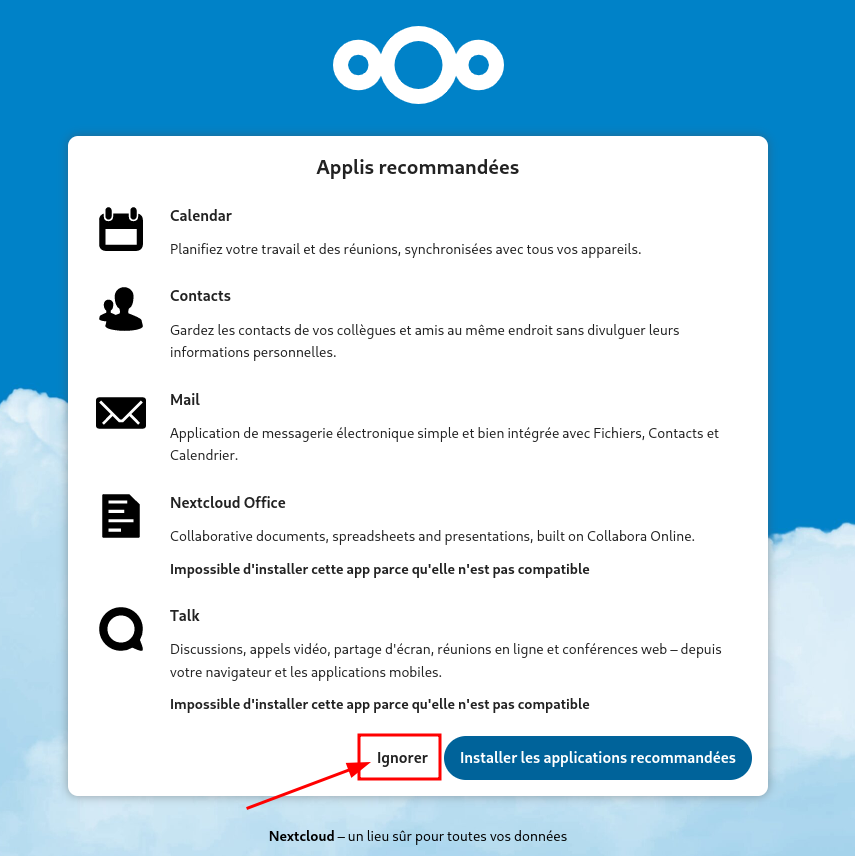
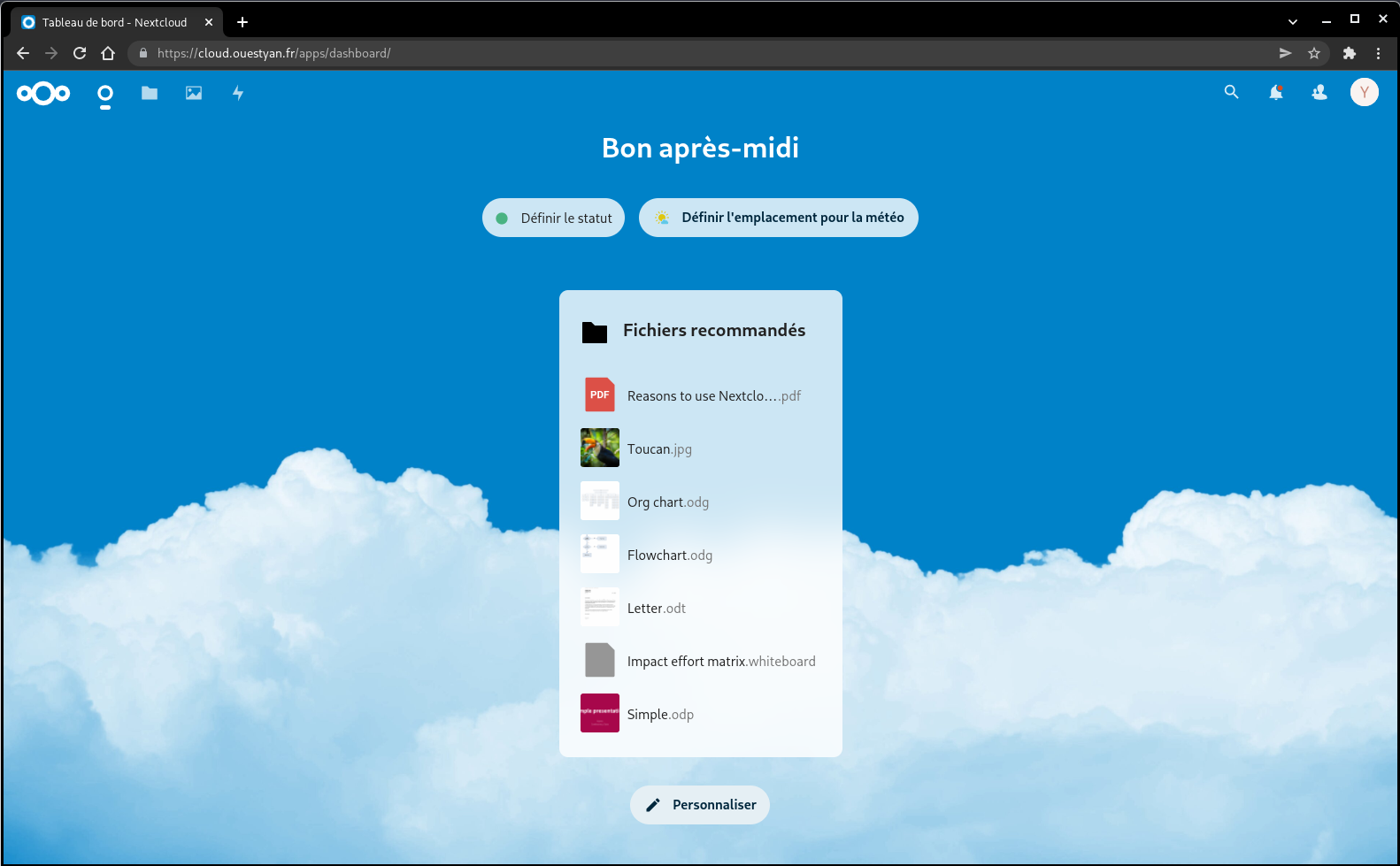
Renseigner adresse de messagerie de destination pour l’utilisateur

Serveur e-mail et cron
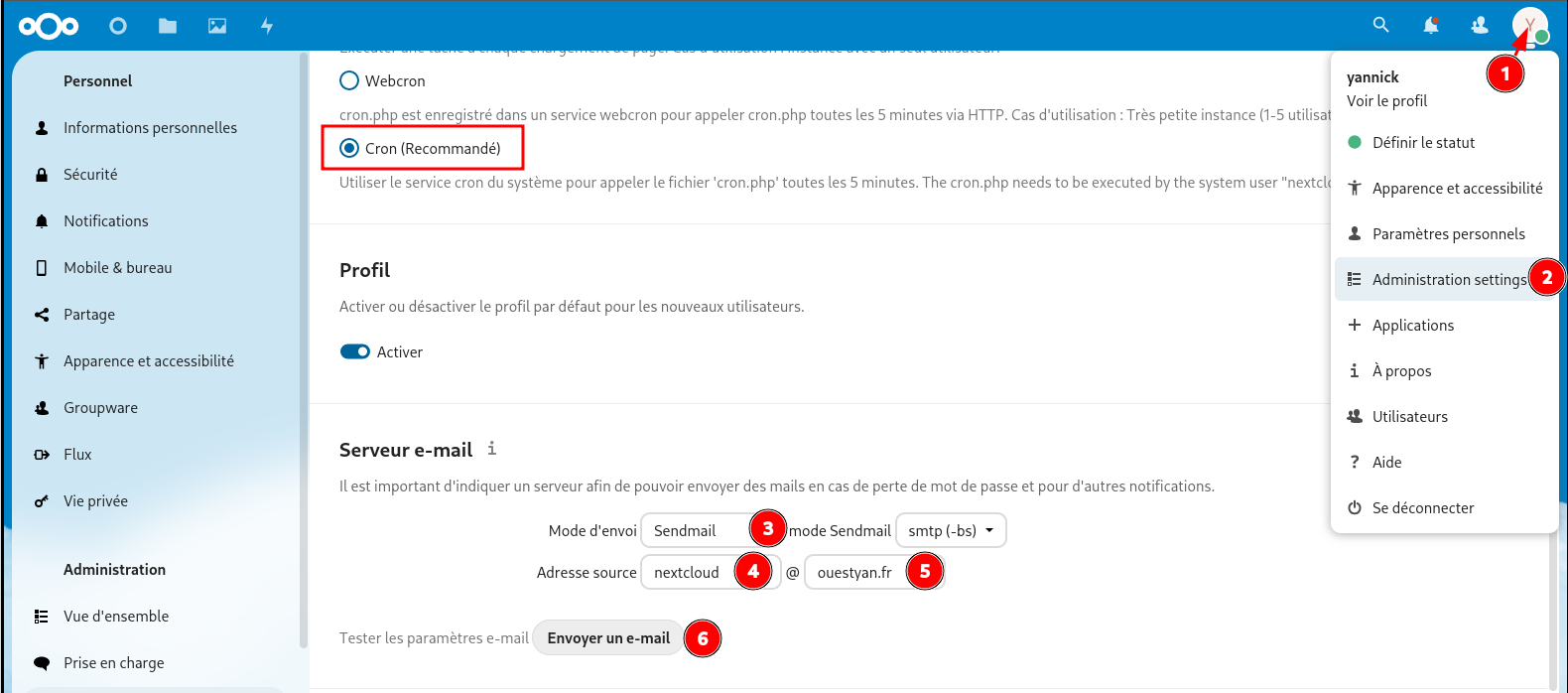
Dans “Administration” → “Paramètres de base”
Apparence thème sombre dans la rubrique “Apparence et accessibilité”
En ligne de commande
Ajouter 'default_phone_region' => 'FR', et les lignes suivantes dans le fichier /var/www/nextcloud/config/config.php avant le tag de fin de fichier );
'default_phone_region' => 'FR',
'filelocking.enabled' => true,
'memcache.locking' => '\OC\Memcache\Redis',
'memcache.local' => '\\OC\\Memcache\\APCu',
'redis' => array(
'host' => 'localhost',
'port' => 6379,
'timeout' => 0.0,
'password' => '',
),
La nouvelle configuration PHP sera prise en compte après redémarrage du service PHP-FPM :
sudo systemctl restart php8.1-fpm.service
Ouvrir le lien https://cloud.ouestyan.fr et vérifier le paramétrage
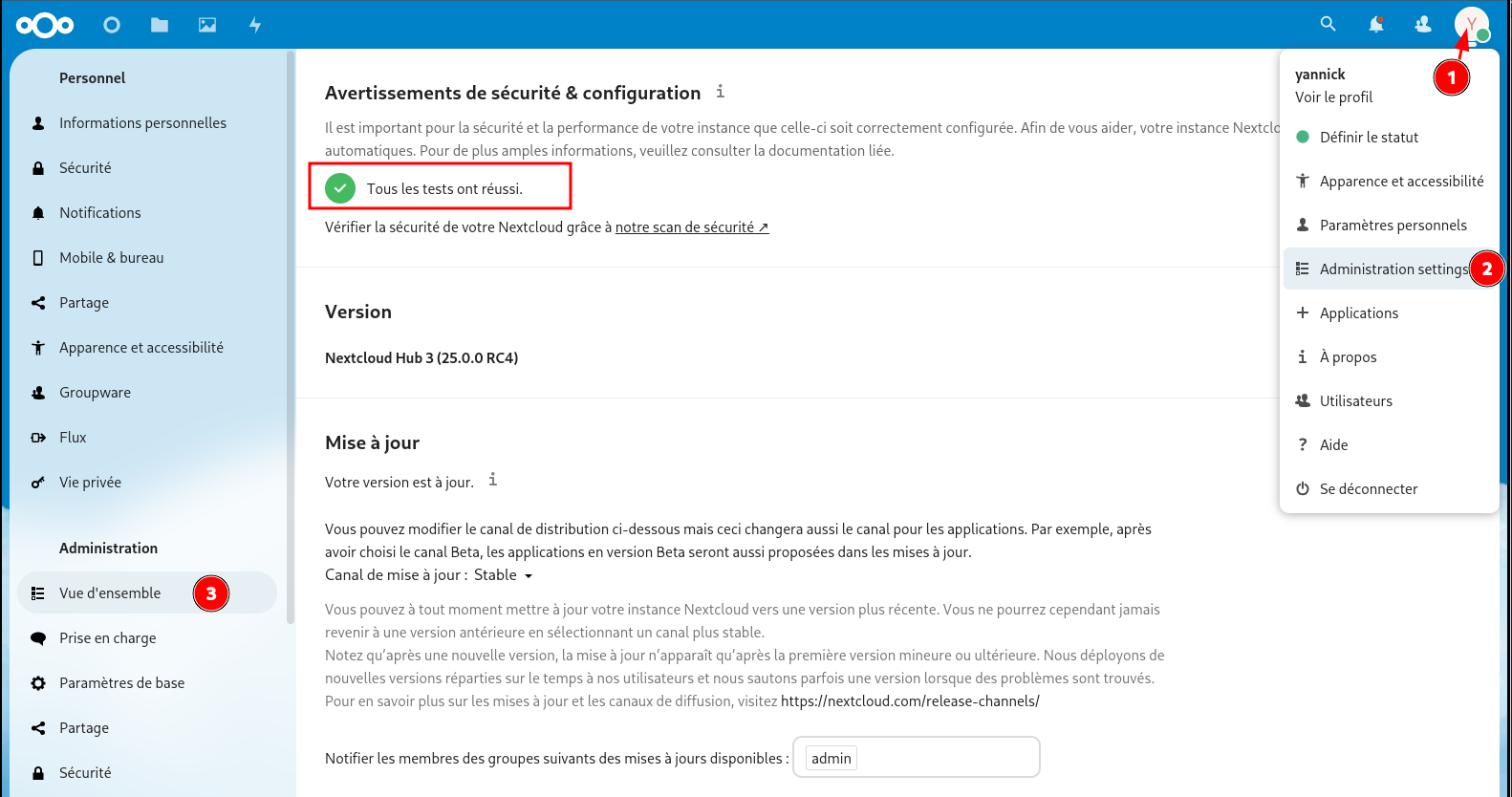
Thème
Paramètres → Apparence et accessibilité
Choix du “Thème sombre” et d’un arrière-plan
Authentification double facteur
Paramètres → Applications → Sécurité
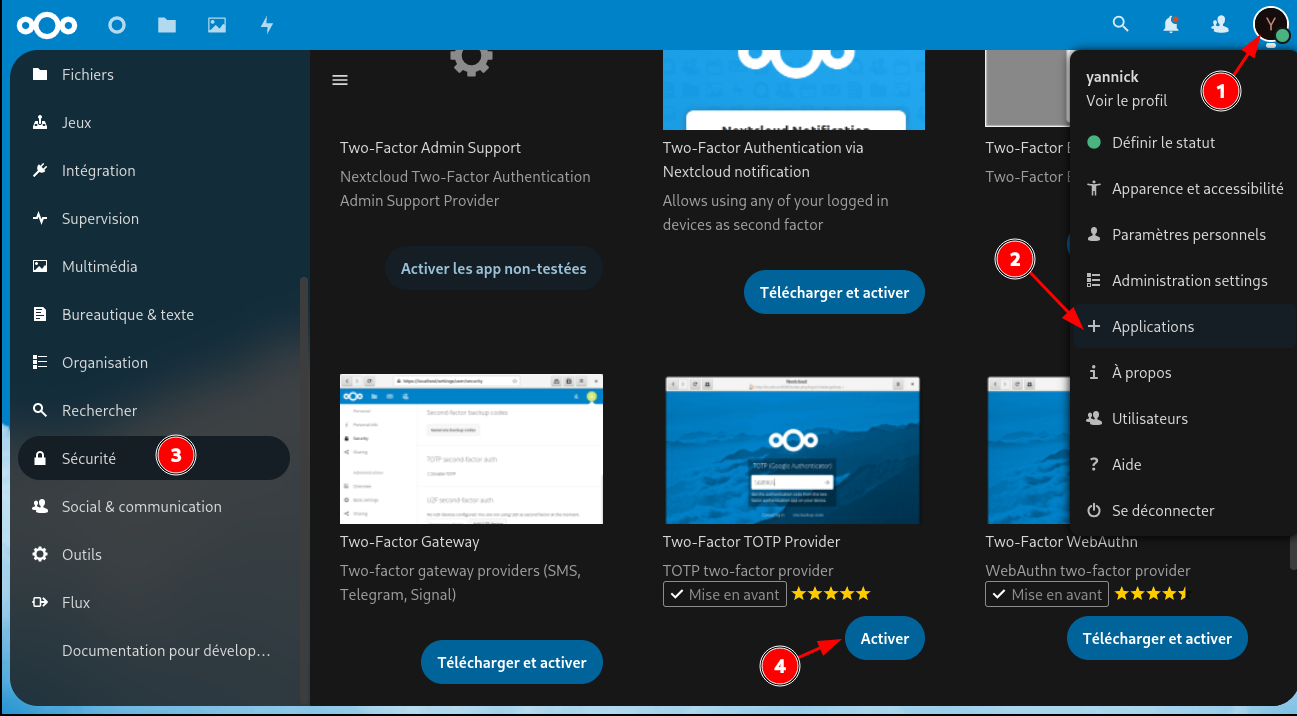
Activer “Two-Factor TOTP Provider”
Paramètres → Administration settings → Sécurité dans la rubrique Administration
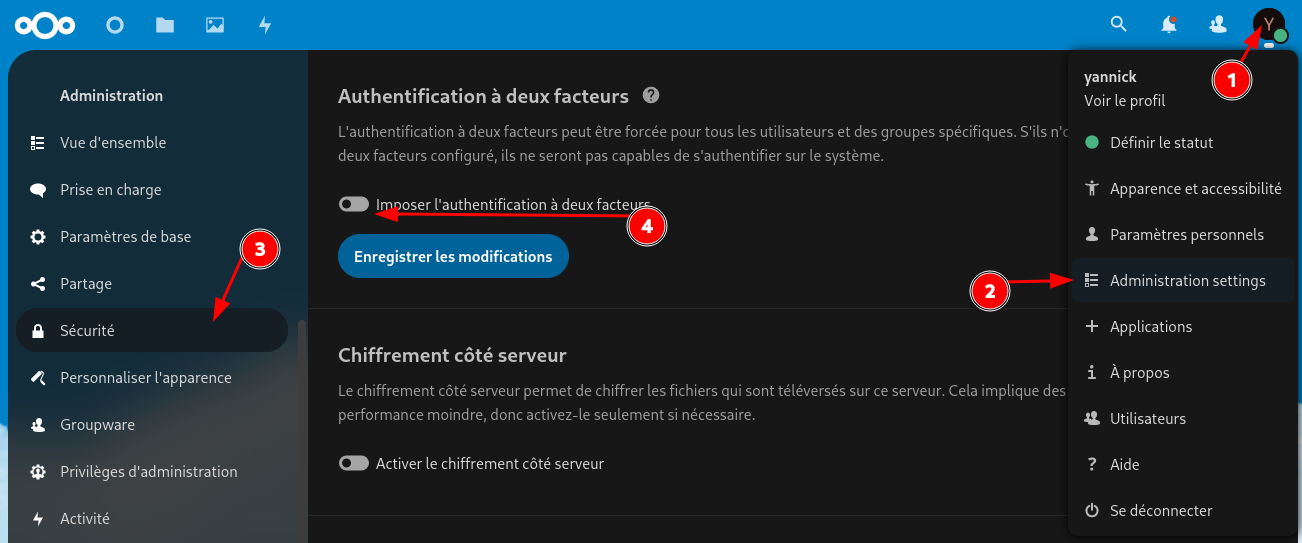
Puis cliquer sur Enregistrer les modifications
Aller ensuite sur Paramètres personnels → Sécurité dans la rubrique Personnel

Après avoir activé authentification TOTP (saisie du mot de passe)
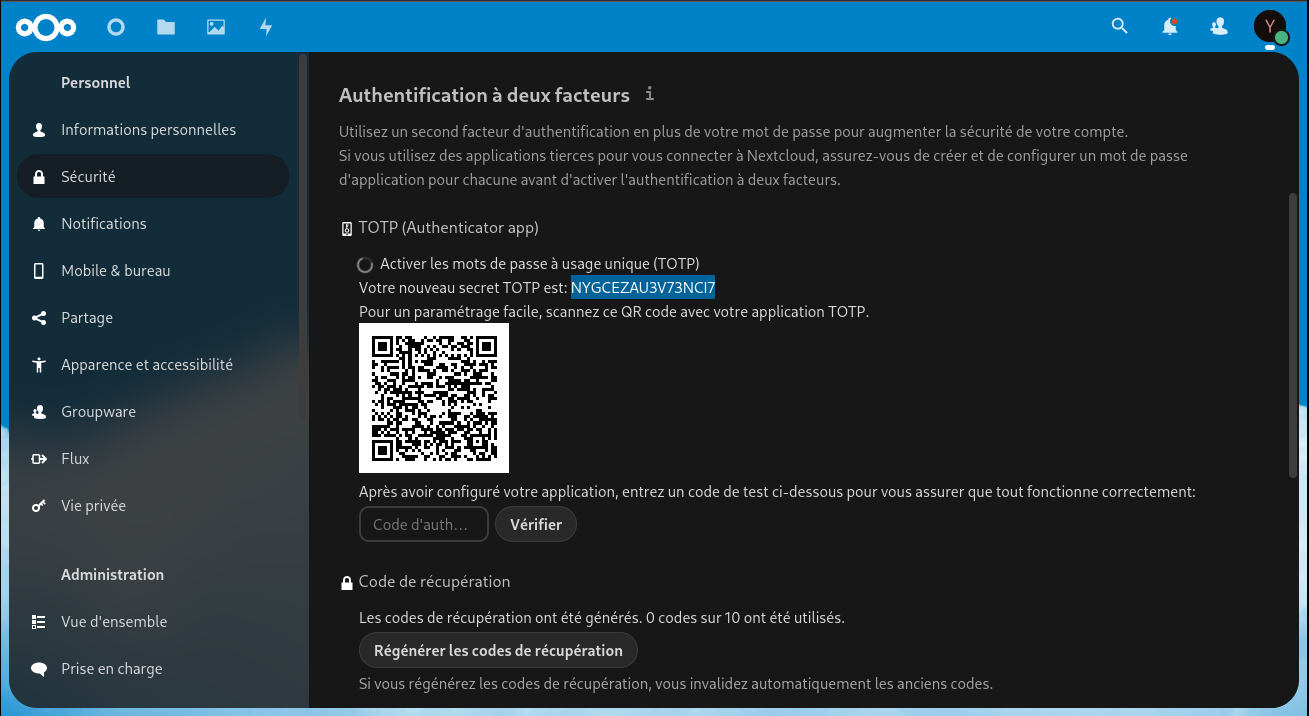
Enter le secret TOTP dans le ou les applications TOPT
Saisir le code de vérification générer par votre application et cliquer sur “Vérifier”
Ensuite cliquer sur “Générer des codes de récupération”

nextcloudcmd
Synchronisation ponctuelle en ligne de commande
La syntaxe
nextcloudcmd --user "Utilisateur" --password "Mot de passe" \
--path /DossierDistant \ # DossierDistant existant sur le serveur nextcloud
/DossierLocal \ # DossierLocal
https://cloud.domain.tld # URL serveur nextcloud
Avec cette syntaxe, le contenu du dossier local sera synchronisé avec le contenu du dossier distant